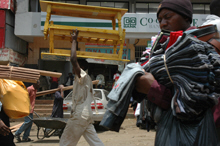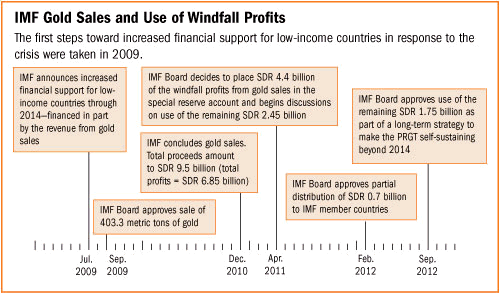
Typical street scene in Santa Ana, El Salvador. (Photo: iStock)
IMF Survey: IMF Support to Poor Countries Gets Needed Boost
October 4, 2012
- Windfall profits from gold sales to help low-income countries
- IMF addresses expected decline in its concessional lending capacity
- Poverty Reduction and Growth Trust to become self-sustaining
The IMF has approved distribution of additional profits from gold sales as part of a strategy to support low-interest lending to poor countries.

Downtown Nairobi: The IMF approved a $508.7 million loan to Kenya in 2011 under the Extended Credit Facility (IMF photo)
IMF Lending to Low-Income Countries
The 2009–10 gold sales generated profits of SDR 6.85 billion ($10.5 billion), some SDR 2.45 billion above the amount envisaged for an endowment to reduce the IMF’s reliance on lending income to cover its operational expenses. An earlier distribution of SDR 0.7 billion ($1.1 billion) of these excess (or “windfall”) profits is helping generate subsidy resources for concessional lending to low-income countries during the crisis. The IMF has now taken a similar decision to distribute the remaining SDR 1.75 billion ($2.7 billion) as part of a strategy to generate additional financial resources for the Poverty Reduction and Growth Trust (PRGT), the IMF’s concessional lending vehicle.
An IMF report released in September warned that the sharp drop in PRGT financing capacity after 2014 needed to be addressed for the IMF to maintain its capacity to help low-income countries in the future and support their efforts to promote strong and sustainable growth. The report also noted IMF support helped low-income countries navigate the crisis and promote longer-term poverty reduction and growth, but that these countries remain exposed to global risks and volatility.
Longer-term sustainability
Reforms agreed to in 2009 doubled poor countries’ access to concessional financing and reduced interest rates to zero, supported by a concessional financing package for 2009–14. After 2014, a “self-sustained” PRGT relying solely on its remaining resources to generate necessary additional subsidy resources—which are needed to fund the concessional rates of interests on loans—would have been able to subsidize loans to the tune of only about SDR 0.7 billion per year, well below the lower bound of projected borrowing needs of low-income countries. The IMF estimates these needs to be in the range of SDR 1.0—1.7 billion over the next decade.
How the PRGT Works
PRGT operations are conducted through three types of accounts within the PRGT:
The Loan Accounts borrow resources generally at market-related interest rates from central banks, governments, and official institutions, and lend them to PRGT-eligible countries.
The Reserve Account provides security to the lenders to the Loan Accounts in the event of delayed or nonpayment by PRGT borrowers, and covers the IMF’s costs of administering PRGT operations.
The Subsidy Accounts receive contributions from bilateral sources—typically provided as grants by contributing member countries—and contributions from the IMF’s own resources to subsidize the rate of interest on PRGT loans to borrowers. These resources finance the difference between the market rate of interest paid to PRGT lenders and the rate of interest paid by borrowers.
To address the anticipated shortfall, the IMF plans to distribute to members the remaining windfall profits from gold sales to facilitate subsidy resources from members for the PRGT, raising the self-sustaining capacity of the PRGT to around SDR 1¼ billion.
“The IMF has long-recognized the desirability of a self-sustained vehicle for concessional lending to low-income countries. Among other things, it introduces greater certainty that the IMF will be able to meet the borrowing needs of its low-income member countries in the longer-term,” said Robert Powell of the IMF’s Finance Department. “The PRGT borrows from IMF member countries and then lends these funds on to low-income countries in need, but in order to do so at below-market rates of interest, subsidy resources are required. Resources linked to the windfall profits from gold sales will help with this.”
In moving ahead with the distribution, the IMF will use the same method applied in the context of the earlier distribution of SDR 0.7 billion. Because the windfall profits from the gold sales are part of the IMF’s general resources available for the benefit of the entire membership, they cannot be placed directly in the PRGT, which is available only to low-income countries.
Accordingly, the distribution to all IMF members of SDR 1.75 billion will be made in proportion to their quota shares, with the expectation that members would direct the IMF to transfer these resources (or would provide broadly equivalent amounts) to the PRGT as subsidy contributions. The distribution will be effected only after members have provided satisfactory assurances that new amounts equivalent to at least 90 percent of the amount distributed—i.e., SDR 1.575 billion—will be transferred, or otherwise provided, to the PRGT.
Three pillars of sustainability
The use of the remaining windfall profits from gold sales to facilitate subsidy resources from members for IMF concessional lending is part of a strategy to make the PRGT sustainable over the medium and longer term. The strategy rests on three pillars:
• A base envelope of SDR 1¼ billion (about $1.9 billion) in annual average PRGT lending capacity is expected to cover concessional financing needs over normal periods. A self-sustaining PRGT can build up capacity in years when there is a lower demand for loans, and then draw down capacity in years with higher demand.
• Contingent measures can be put in place to help deal with times when average financing needs substantially exceed the base envelope for an extended period. These measures include bilateral fundraising efforts and suspending temporarily the reimbursement of the PRGT’s administrative expenses.
• A principle of self-sustainability would be applied in any future modifications to low-income country lending facilities. For example, when the periodic reviews of PRGT eligibility and lending facilities are held they would be expected to ensure that all modifications, taken together, would keep demand consistent with available resources.
“This strategy is designed to match the unique nature of IMF support to low-income countries. IMF financial assistance is essentially demand driven and thus tends to be highly cyclical” said Christian Mumssen from the IMF’s Strategy, Policy, and Review Department. “While short-run fluctuations in demand can be accommodated within the base envelope, the framework allows for contingent mechanisms that can be activated when global shocks lead to a sharp and sustained increase in financing needs.”
Lower loan rates
The PRGT has been fully operational since reforms to its predecessor became effective in January 2010. Lending commitments to low-income countries have been approved under all three PRGT facilities, the Extended Credit Facility, Standby Credit Facility, and the Rapid Credit Facility.
In response to the increasing financial needs of low-income countries during the global financial crisis, IMF concessional lending increased significantly from $1.2 billion in 2008 to $3.8 billion in 2009, and $1.8 billion in 2010 to $1.9 billion in 2011.
Following the onset of the global financial crisis, low-income countries received exceptional relief of all interest payments on outstanding concessional loans due to the IMF through the end of 2011—effectively, an interest rate of zero on these loans for this period. The period was later extended to end-2012.
The interest rate on the three PRGT facilities will be reviewed regularly thereafter under a mechanism that preserves a higher level of concessionality than before. Previously, the interest rate on borrowing from all PRGT facilities was 0.5 percent. Under this new mechanism, the interest rate applicable to loans outstanding under the ECF and the RCF would remain at zero percent through 2013, while SCF credit would be subject to a rate of 0.25 percent.








